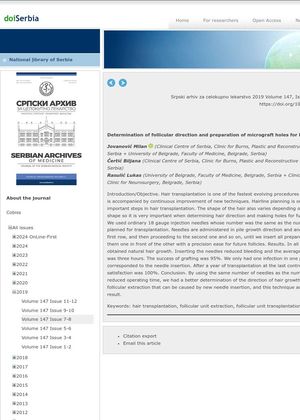Determination of Follicular Direction and Preparation of Micrograft Holes for Hair Transplantation
January 2019
in “
Srpski Arhiv Za Celokupno Lekarstvo
”

TLDR The technique improved hair transplant success and patient satisfaction by matching hair growth direction.
The 2019 study "Determination of follicular direction and preparation of micrograft holes for hair transplantation" by Jovanović Milan et al. involved 56 patients and focused on improving hair transplantation techniques. The researchers used the same number of 18 gauge injection needles as the planned number of micrografts for transplantation. The needles were inserted in the direction and angle of hair growth, which reduced bleeding and operation time to an average of three hours. The success rate of grafting was 95%, with only one infection reported. After a year, hair growth corresponded to the needle insertion and patient satisfaction was 100%. The study concluded that this technique allowed for better determination of hair growth direction, prevention of follicular extraction caused by new needle insertion, and achieved good aesthetic results.


